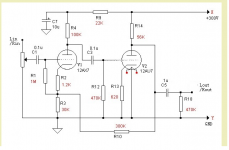Hi, I'm looking to build a 12AX7 tone control based on this
Practical Tone Controls.
However, I wonder if I can use a low B+ voltage of say 30V instead of 250V.
The reason is I can easily lay my hand on 30V transformer.
Thanks in advance for any comment / suggestion.
Practical Tone Controls.
However, I wonder if I can use a low B+ voltage of say 30V instead of 250V.
The reason is I can easily lay my hand on 30V transformer.
Thanks in advance for any comment / suggestion.
The 12AX7 does not like low supply rail voltages. The high mu means that the grid bias will be small so grid current will be an issue. If you want low voltage then you need to choose a different valve.
Bone's right. A simple voltage doubler would get you to nearly 80 volts. While the 12AX7 would still prefer a bit more... at least you're in the region where it could be made to work.
Take a look at https://en.wikipedia.org/wiki/Voltage_doubler , especially the Greinacher circuit topology. There are other topologies, but this is pretty darn good.
GoatGuy
Take a look at https://en.wikipedia.org/wiki/Voltage_doubler , especially the Greinacher circuit topology. There are other topologies, but this is pretty darn good.
GoatGuy
Get 12VDC brick adapter for your heaters. Spare a few extra watts for this module and you can get any high voltage you need..DC DC Boost Converter 8 32V to 45 390V High Voltage ZVS Capacitor Charging Board | eBay
Get 12VDC brick adapter for your heaters. Spare a few extra watts for this module and you can get any high voltage you need..DC DC Boost Converter 8 32V to 45 390V High Voltage ZVS Capacitor Charging Board | eBay
huh, those are $10 shipped via aliexpress.
Gives me ideas. I have some very old stock "computer grade" capacitors -- I'm aware of the warnings that if i just go ahead and hook them up to high voltage as is they might react violently. I'm not sure if i believe the idea of "re-forming" the electrolyte by gradually increasing voltage, but if i wanted to try that, this would work for that.
Here's a voltage doubler I did to get some more voltage from a power supply in an old CD player:
I also used the existing negative supply to get me some more voltage to run the tubes.
An externally hosted image should be here but it was not working when we last tested it.
I also used the existing negative supply to get me some more voltage to run the tubes.
Check out this Broskie Sextupler
Click on the link. With 18VAC in over 100 volts out for B+ and lower V higher A for filaments.
Cheers, Steve
Aikido 12Vac
Click on the link. With 18VAC in over 100 volts out for B+ and lower V higher A for filaments.
Cheers, Steve
Aikido 12Vac
Believe it; it is true. Reforming electrolytics (not the electrolyte, but the oxide layer) is a standard technique used by people working on ancient electronics. The idea is to keep the current low, so little or no gassing takes place; you want all the current to be used in reforming the oxide, not producing gas.ericj said:I'm not sure if i believe the idea of "re-forming" the electrolyte by gradually increasing voltage, but if i wanted to try that, this would work for that.
... Reforming electrolytics (not the electrolyte, but the oxide layer) is a standard technique used by people working on ancient electronics. ...
Nowadays when TV collectors or vintage tube amp restorers restore such, we essentially gut the old cap cap and stuff it with modern caps. Caps made nowadays are much better (assuming you don't get ones made with the bad stolen cap recipe, but that was ten year ago). If you go to this trouble, get the 105C caps, as they last better.
6N14P is a low voltage tube. Also, Collins used in R392/URR receiver (High - end shortwave radio) 12AX7 and 6AK5 tubes. However, no expectations of low distortions!
Last edited:
Try Looking up a 12AJ6 or a 12EL6 ...
You might be surprised when looking at the data sheets....
You might be surprised when looking at the data sheets....
Yes, some people do that. Some people re-form the old ones if possible, only replacing them if necessary. I said reforming is "a standard technique", not 'the standard technique'.wa2ise said:Nowadays when TV collectors or vintage tube amp restorers restore such, we essentially gut the old cap cap and stuff it with modern caps.
Thanks everyone for the inputs. Since 12AX7 has small plate current, I think my best option is DC-DC high voltage converter suggested by ballpencil.
Now my question is this tone control good enough as a pre-amp? or should I add a pre-amp as attached?
If yes, should the pre-amp leading or trailing the tone control?
Thanks again.
Now my question is this tone control good enough as a pre-amp? or should I add a pre-amp as attached?
If yes, should the pre-amp leading or trailing the tone control?
Thanks again.
Attachments
Duncan Amps has a tone stack simulator program you can download for free. That's a guitar amp term (and company) but the concepts are entirely the same.
It is difficult to think of a purpose in a modern hi-fi system which would be served by a preamp with voltage gain around 10.cl1238 said:or should I add a pre-amp as attached?
- Status
- Not open for further replies.
- Home
- Amplifiers
- Tubes / Valves
- 12AX7 tone control with low B+ voltage
